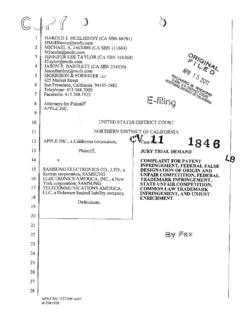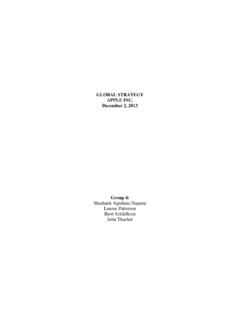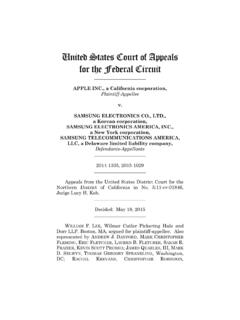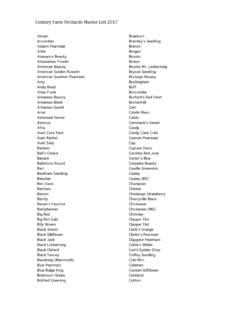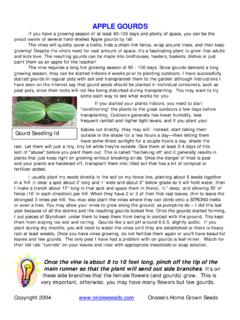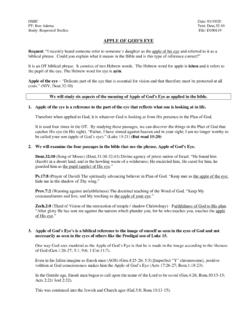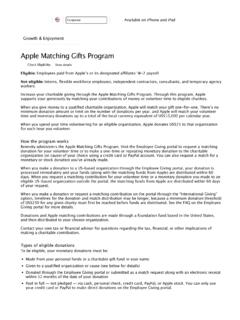Transcription of Apples: Safe Methods to Store, Preserve, and Enjoy
1 Apples: Safe Methods to Store, Preserve, and EnjoyLINDA J. HARRIS, Food Safety and Applied Microbiology Specialist, Department of Food Science and Technology, UC Davis; SYLVIA YADA, Scientist, Department of Food Science and Technology, UC Davis; and ELIZABETH MITCHAM, Postharvest Extension Specialist, Department of Plant Sciences, UC DavisW H AT A R E A P P L E S ?The apple (Malus domesticus) is a pome (from the Latin word for apple ), a fruit with a papery central cavity surrounding the seeds (fig. 1). Pomes are members of the Roseaceae (rose) family, which also includes pear, crabapple, and data show that humans were eating apples as early as 6500 Evidence indicates that the fruit was first cultivated between the Caspian Sea and the Black apple was brought to North America by the Europeans nearly 400 years ago.
2 Pilgrims planted orchards in the Massachusetts Bay Colony. Some people who came to California for the Gold Rush brought apple seeds with them. Soon after California joined the Union in 1850, apple orchards were planted. Today, apples are grown in California on farmlands surrounding the communities of Mendocino and Sonoma in the north, in the San Joaquin Valley and coastal areas of Central California, and in Tehachapi and Julian (near San Diego) in the is an important apple -producing state, growing more varieties than any other state west of the Rocky Mountains. Heritage varieties, such as Pippins, Gravensteins, and Winesaps, do well throughout California, as do old favorites like Red and Golden Delicious, Granny Smith, and Jonathan. Cooking apples, such as Northern Spy and Rome Beauty, and newer varieties like Pink Lady, Fuji and Gala, all grow successfully in California orchards (table 1).
3 PUBLICATION 8229 UNIVERSITY OF CALIFORNIAD ivision of Agriculture and Natural 1. Whole and cross section of an apple showing seed pattern. ANR Publication 8229 NOTE: Research on food preservation is ongoing recommendations may change. Make sure your food preservation information is always current. Always follow up-to-date, tested guidelines and recipes from reliable sources. 3/2007N U T R I T I O NApples are a significant source of pectin fiber (3 g per medium apple ), and they pro-vide carbohydrates and vitamins while contributing few calories and no fat, sodium, or cholesterol (fig. 2). G R O W I N G A P P L E S I N T H E H O M E G A R D E NInformation on growing apples is available online through the University of California, Davis, Backyard Orchard homepage at The site contains useful information on apple varieties for planting in the home garden, man-agement of apple pests, such as aphids and mites, and control of disorders, such as San Jose scab and powdery mildew.
4 A free online publication from the University of California, Key Points of Control and Management of Microbial Food Safety: Edible Landscape Plants and Home Garden Produce, (UC ANR Publication 8101), pro-vides information on ways to minimize contamination of fruits and vegetables in the home garden by organisms that can cause foodborne illness. You can access the publication at E L E C T I N G A P P L E S F R O M T H E H O M E G A R D E N O R P I C K -YO U R - O W N S I T ESelect firm apples, free of breaks in the skin, and with a background color (the non-red part of the apple skin) that is light yellow or yellow-green. Harvest the fruit by lifting toward the sky to release the stem from the tree, rather than by pulling, which can tear out the stem, damage the tissue, and shorten the storage life of the E L E C T I N G A P P L E S AT T H E G R O C E R Y S T O R EChoose apples that are firm, with a good aroma.
5 Avoid fruit with bruises, shriv-eling, or skin breaks. The amount of red color on the surface of a red or striped apple is not an indicator of its eating quality. In fact, some studies have shown that redder apples may have fewer flavor compounds. The taste quality of the apple depends on when it was harvested during its development, how long it has been in storage, and the environmental conditions in 2. Nutrition facts for apples with skin on (1 medium, 23/4 diameter). Source: USDA National Nutrient FactsServing Size (138 g)Amount Per ServingCalories 72 Calories from Fat 2% Daily Value*Total Fat 0 g0% Saturated Fat 0 g0%Cholesterol 0 mg0%Sodium 1 mg0%Total Carbohydrate 19 g6% Dietary Fiber 3 g13% Sugars 14 gProtein 0 gVitamin A1% Vitamin C11%Calcium1% Iron1%*Percent Daily Values are based on a 2,000 calorie diet.
6 Your daily values may be higher or lower depending on your calorie 1. Selected California apple varieties, flavors, and usesVarietyFlavorRecommended usesFujisweetfresh, sauce, freezingGalasweetfresh, sauce, drying, freezingGolden Delicioussweet, mellowfresh, pies, sauce, canning, freezingGranny Smithtart to slightly sweetfresh, pies, sauce, canning, freezingGravensteinsweet to tartfresh, pies, sauce, drying, freezingJonathanslightly tartfresh, pies, sauce, freezingPink Ladysweet to tartfresh, pies, sauce, freezingRed Delicioussweetfresh Rome Beautyslightly tartbaking whole, sauce, drying, freezingSource: apple Association Web site, ANR Publication 8229 NOTE: Research on food preservation is ongoing recommendations may change. Make sure your food preservation information is always current.
7 Always follow up-to-date, tested guidelines and recipes from reliable sources. 3/2007S T O R I N G F R E S H A P P L E SApples keep best in your refrigerator, preferably in the crisper drawer or in an unsealed plastic bag. Refrigerate apples separately from vegetables because apples nat-urally release small amounts of ethylene gas that can be damaging to lettuce and other produce. Apples can be held in an open container on a table for a few days before eat-ing, if desired, but more time at room temperature will lead to shriveling and a loss of flavor and brown pits sometimes develop on the skin of apples in storage, and the underlying apple tissue is also brown. This is a common disorder of apples, called bit-ter pit, caused by a deficiency of calcium within the fruit as it develops on the tree.
8 It is particularly common in large apples. These apples can be eaten without worry, but you may want to cut away the affected tissue prior to A F E T Y T I P S F O R H A N D L I N G F R E S H A P P L E SGeneral SanitationContaminated produce and unpasteurized apple juice or cider have been known to cause foodborne illness. Like any other fresh fruit or vegetable, apples can be con-taminated by bacteria from soil, water, and animal sources, or from lack of sanitation during preparation or processing. Contamination from human sources may occur during or after harvest, right up to the point of eating. Contamination at home may also occur when poorly washed utensils or cutting boards (especially those used to handle raw meats) are used to prepare fresh fruits or vegetables.
9 For this reason, it is important that you wash your hands with soap and water before and after preparing produce, and use clean equipment, utensils, and cutting ApplesApples should be washed just before eating or preserving. To wash, rub each apple under running water or use a clean scrub brush, and then dry it with a clean paper the fruit in a sink filled with water is not recommended since the stand-ing water can spread contamination from one apple to another. The use of soap or detergent is not recommended or approved for washing fruits and vegetables because the produce can absorb detergent residues. The stem area and blossom end of apples are the most difficult to clean. To avoid these areas you can cut around the core rather than through it or you can use an apple coring ApplesCut or sliced apples should be covered and refrigerated if they are not eaten within 2 hours of preparation; this reduces browning and maintains quality and E T H O D S F O R P R E S E R V I N G A P P L E SLight-colored fruits, such as apples, will brown after they are cut or peeled because of enzyme activity in the fruit.
10 There are several ways to reduce browning during preparation and storage, and details of recommended treatments are provided with each preservation method. In general, you need to use the strongest treatments for drying apples, less for freezing, and the least strong for canning reduce browning and to maintain both quality and safety, always cover and refrigerate cut or sliced apples when pre-paring them in advance or after purchasing precut apples at the grocery store. ANR Publication 8229 NOTE: Research on food preservation is ongoing recommendations may change. Make sure your food preservation information is always current. Always follow up-to-date, tested guidelines and recipes from reliable sources. 3/2007 Using ascorbic acid to prevent browningA common and effective treatment to keep apples from browning is to use ascorbic acid (Vitamin C) in a dipping solution or by adding it directly to the fruit or syrup.





